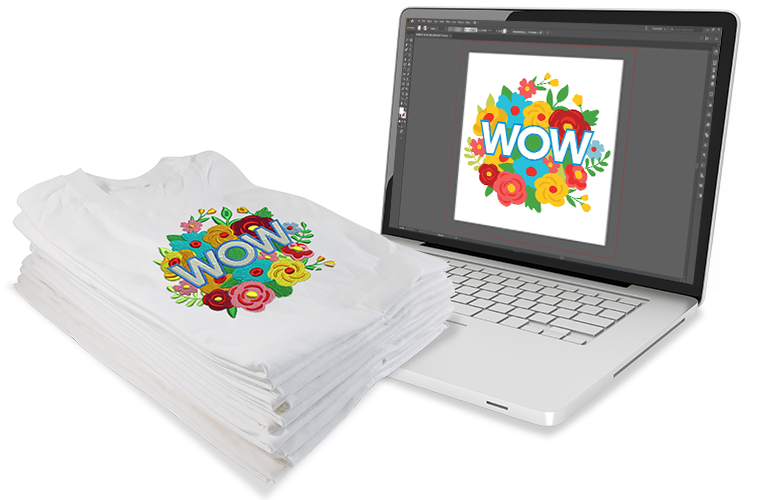Mastering the Embroidery Digitizing Refine: Your Ultimate Guide
Needlework digitizing is a thorough craft that requires accuracy and knowledge to equate intricate designs right into electronic styles for machine needlework. As craftsmens embark on this trip to grasp the embroidery digitizing procedure, a detailed understanding of the basics establishes the foundation for quality.

Comprehending Needlework Digitizing Essentials
Embroidery digitizing basics develop the structure upon which elaborate layouts are translated right into machine-readable formats for precise sewing. This initial action in the embroidery digitizing process is crucial for guaranteeing that the last stitched item is a devoted depiction of the original style. Comprehending needlework digitizing fundamentals includes grasping key ideas such as stitch types, sew instructions, density, padding, and pull settlement.
Stitch types play an essential role in identifying the visual and textural outcome of the embroidered style. By choosing the appropriate stitch kind, whether it be satin, fill, or running stitch, digitizers can accomplish the preferred result and enhance the total high quality of the embroidery. In addition, stitch instructions influences the circulation and dimension of the style, while density identifies the spacing and coverage of the stitches.
Moreover, padding stitching supplies stability to the design by protecting the textile and avoiding distortion during the embroidery procedure. Pull settlement is another crucial consideration to counteract the natural propensity of fabric to contract when stitched. Grasping these embroidery digitizing essentials is basic for creating professional-quality stitched products.
Choosing the Right Digitizing Software
Picking the proper digitizing software is a crucial decision that substantially impacts the effectiveness and high quality of the embroidery digitizing process. Digitizing for Embroidery. When selecting the appropriate digitizing software program, it is crucial to consider variables such as the complexity of styles you plan to create, the user-friendliness of the software application, the level of client support provided, and the compatibility with your needlework maker
There are different digitizing software options available in the marketplace, varying from basic programs for newbies to sophisticated software application for expert digitizers. Some preferred options consist of Wilcom EmbroideryStudio, Hatch Needlework Software Program, and PulseID. These software supply a vast array of devices and functions to assist you produce complex designs effortlessly.
Prior to making a decision, it is a good idea to check out the various software options with complimentary trials or demos to figure out which one finest matches your requirements. Additionally, reading evaluations and seeking suggestions from knowledgeable digitizers can offer valuable insights right into the toughness and weaknesses of each software package (Digitizing for Embroidery). By thoroughly reviewing your demands and comparing the features of different digitizing software, you can make an educated selection that enhances your embroidery digitizing operations
Digitizing Devices and Strategies

Optimizing Layout Setup for Embroidery
Mastering the details of style setups is essential in attaining optimal results in the needlework digitizing procedure, building upon the foundation laid by understanding digitizing devices and strategies. When optimizing layout setups for embroidery, it is essential to consider variables such as stitch type, density, padding, pull payment, and enrollment. Registration settings line up different aspects of the design precisely, maintaining general layout integrity.

Troubleshooting Common Digitizing Issues
When coming across common digitizing issues during the needlework procedure, it is important to understand the source and apply efficient solutions quickly. One common trouble is stitch density problems, where stitches might be also dense, creating the textile to tighten, or too sparse, leading to voids in the style. Readjusting the stitch density settings in the digitizing software program can help solve this problem.
Another constant difficulty is string breaks during the needlework process. This can take place because of numerous reasons such as wrong tension setups, dull needles, or using low-grade string. Making certain proper upkeep of the embroidery device, including normal needle adjustments and tension modifications, can minimize the occurrence of string breaks.
Additionally, style registration errors can result in misaligned elements within the embroidery layout. Examining the design placement in the digitizing software program and making required adjustments pop over to these guys before sewing can assist in preventing this problem. By addressing these common digitizing issues promptly and successfully, you can ensure a smoother needlework procedure and high-quality completed products.
Verdict
Finally, mastering the needlework digitizing process calls for a solid understanding of the basics, the best option of Read More Here software program, and expertise of devices and strategies. Enhancing layout setups and fixing usual digitizing concerns are essential action in ensuring top notch embroidery outcomes. By following these steps vigilantly, one can accomplish accuracy and effectiveness in the digitizing procedure.